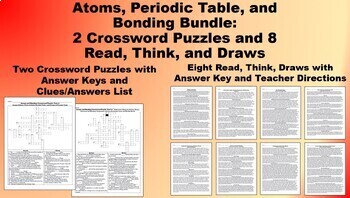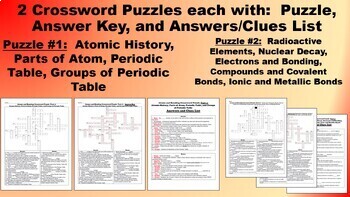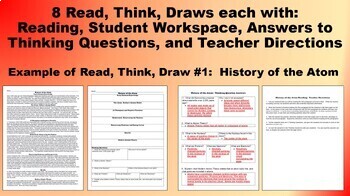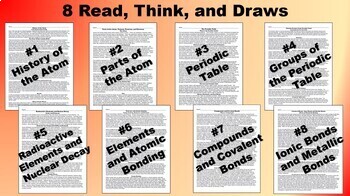Atoms, Periodic Table, and Bonding Bundle: 2 Crossword Puzzles, 8 Readings
- Zip
Products in this Bundle (9)
showing 1-5 of 9 products
Description
This resource is a Bundle of 9 files on Atomic History, Parts of the Atom, The Periodic Table, Groups of the Periodic Table, Radioactive Elements, Nuclear Decay, Electrons and Bonding, Compounds and Covalent Bonds, and Ionic and Metallic Bonds: (1) Atoms, Periodic Table, and Bonding Crossword Puzzles, (2) History of the Atom: Read, Think, and Draw, (3) Parts of the Atom: Read, Think, and Draw, (4) Periodic Table: Read, Think, and Draw, (5) Groups of the Periodic Table: Read, Think, and Draw, (6) Radioactive Elements and Nuclear Decay: Read, Think, and Draw, (7) Elements and Atomic Bonding: Read, Think, and Draw, (8) Compounds and Covalent Bonding: Read, Think, and Draw, and (9) Ionic Bonds and Metallic Bonds: Read, Think, and Draw.
Resource #1: This resource is two Crossword Puzzles on Atomic History, Parts of the Atom, The Periodic Table, Groups of the Periodic Table, Radioactive Elements, Nuclear Decay, Electrons and Bonding, Compounds and Covalent Bonds, and Ionic and Metallic Bonds. This resource is 6 pages: Page 1 and 2 are the two Crossword Puzzles, and should be printed front to back for your students. Page 1: Crossword Puzzle #1 is about: Atomic History, Parts of the Atom, The Periodic Table, and Groups of the Periodic Table. Page 2: Crossword Puzzle #2 is about: Radioactive Elements, Nuclear Decay, Electrons and Bonding, Compounds and Covalent Bonds, and Ionic and Metallic Bonds. Page 3 is the Answer Key to Puzzle #1. Page 4 is the Answer Key to Puzzle #2. Page 5 is the Answers and Clues list for Puzzle #1. Page 6 is the Answers and Clues List for Puzzle #2. Crossword Puzzle Answers/Content Puzzle #1: Mass Number, JJ Thompson, Ernest Rutherford, Noble Gasses, James Chadwick, Groups of the Periodic Table, Periodic Table, Halogens, Atomic Theory, John Dalton, Empty Space, Dimitri Mendeleev, Electrons Negative Charge, Democritus, Hydrogen, Periods of the Periodic Table, Neutrons Neutral Charge, Neutral Atoms, Protons Positive Charge Atomic Number, and Henry Mosely. Crossword Puzzle Answers/Content Puzzle #2: Valence Electrons, Full set of Valence Electrons, Ionic Compounds, Ionic Bonds, Gamma Decay, Radiation, Chemical Bonds, Positively Charged Ions, Beta Decay, Electron Dot Diagrams, Outermost Electrons, Ion, Unpaired Electrons, Polar Molecule, Atom, Negatively Charged Ions, Radioactive, Compounds, Nonpolar molecules, Metallic Bonds, Alpha Decay, and Nuclear Decay.
Resource #2, Reading #1: This resource is a Read, Think, and Draw about The History Of The Atom. Through the reading students will learn about: Early Knowledge from Democritus and Aristotle, Dalton's Atomic Model and Atomic Theory, JJ Thompson and the Discovery of Electrons, Rutherford and the Discovery of the Nucleus and later discovery of Protons, Chadwick and Bohr and the Discovery of Neutrons and Energy Levels for Electrons, the Discovery of Quarks and their six different types (Up, Down, Charm, Strange, Top, and Bottom), and Modern Atomic Theory and our current model of the Atom.
Resource #3, Reading #2: This resource is a Read, Think, and Draw about Parts of the Atom: Protons, Neutrons, and Electrons. Through the reading students will learn about: Where Protons, Neutrons, and Electrons are found in the Atom, What is the Nucleus, What is the Electron Cloud, Charges of Protons, Neutrons, and Electrons, Net Charge, Neutral Atoms, Atoms and Elements, Periodic Table of Elements, Current Amount of Elements, Atomic Number, Neutrons and Isotopes, Average Atomic Mass, Mass Number, Ions, Positive Ions, Negative Ions, and Removal of Electrons from Atoms.
Resource #4, Reading #3: This resource is a Read, Think, and Draw about The Periodic Table of Elements. Through the reading students will learn about: What is the Periodic Table?, What does periodic mean?, Physical Properties (Luster, Ductility, Malleability, Boiling Point, Melting Point, Density, and Electrical Conductivity), Chemical Properties (Flammability, Acidity, Toxicity, and Reactivity), Periods, Patterns that exist within Periods of Elements on the Periodic Table, Groups, Patterns that exist within Groups on the Periodic Table, Current number of elements on Periodic Table, Dimitri Mendeleev and the creation of the Periodic Table, Henry Mosely and the modification of the Periodic Table, the Current Periodic Table, the Periodic Table arranged by element's Atomic Number, elements that are Metals, Properties of Metals, elements that are Metalloids, Properties of Metalloids, elements that are Non-Metals, and Properties of Non-Metals.
Resource #5, Reading #4: This resource is a Read, Think, and Draw about Element Groups of the Periodic Table. Through the reading students will learn about: The Periodic Table, Periods and Groups, Hydrogen, Group 1: Alkali Metals, Group 2: Alkaline Earth Metals, Groups 3-12 Transition Elements, Lanthanide and Actinide Series, Groups 13-16, Group 17: Halogens, and Group 18: Noble Gases. Students will learn the elements of each group, the properties of each group, Atomic Number, Number of Protons, Number of Electrons, Valence Electrons, Stable and Unreactive Elements, Unstable and Reactive Elements, Metals, Metalloids, and Non-Metals, and Solids, Liquids, and Gases.
Resource #6, Reading #5: This resource is a Read, Think, and Draw about Radioactive Elements and Nuclear Decay. Through the reading students will learn about: Atoms and Elements, Periodic Table of Elements, Atomic Number, Atomic Mass, Atomic Mass Number, Atomic Number is Number of Protons, Effect of Chemical Reactions on Atoms and Atomic Number, Radioactive Elements emit Radiation, What is Radiation, What is Ionizing Radiation, How Radiation Changes Atoms and Atomic Numbers and Number of Protons, Nuclear Decay, Three Types of Nuclear Decay (Alpha Decay, Beta Decay, Gamma Decay), What is an Alpha Particle, How an Alpha Particle changes the Atom, What is a Beta Particle, How a Beta Particle changes the Atom, What are Gamma Rays, and How do Gamma Rays affect the Atom.
Resource #7, Reading #6: This resource is a Read, Think, and Draw about Electrons, Atomic Bonding, and Electron Dot Diagrams. Through the reading students will learn about: Atoms, Protons (Positive Charge), Neutrons (Neutral Charge), Electrons (Negative Charge), Electron Levels, Valence Electrons, Valence Electron Levels, Chemical Bonds, How To Determine Numbers of Valence Electrons, Electron Dot Diagrams, Examples of Electron Dot Diagrams, and Atomic Bonding and Gaining/Losing/Sharing Electrons.
Resource #8, Reading #7: This resource is a Read, Think, and Draw about Compounds, Covalent Bonds, Polar Molecules, and Non-Polar Molecules. Through the reading students will learn about: What is a Compound, Chemical Bonds, Compounds Have Different Properties Than the Atoms They Come From, Covalent Bonds Formed By Shared Electrons, Stable Atoms, Outermost Electrons, Energy Levels, Valence Electrons, Share Electrons, Chemical Compound, Single Bond, Double Bonds, Triple Bonds, Quadruple Bonds, What is a Molecule, What is a Polar Molecule, Slightly Positive Ends of a Molecule, Slightly Negative Ends of a Molecule, What is a Non-Polar Molecule.
Resource #9, Reading #8: This resource is a Read, Think, and Draw about Chemical Bonds: Ionic Bonds and Metallic Bonds. Through the reading students will learn about: Valence Electrons, Protons, Electrons, Outer Energy Levels, Energy Shells, Stable Outer Energy Levels, Metal Atoms, Nonmetal Atoms, Atomic Bonding, Transfer of Electrons, Sharing of Electrons, Nobel Gasses, Neutrally Charged Atoms, Subatomic Particles, Unstable and Reactive Atoms, Cations, Anions, Writing Positive and Negative Charges on Ions, Ionic Bonds, Ionic Compounds, Metallic Bonds, and Pooling Valence Electrons.
Teacher Directions For Read, Think, and Draws:
- Page 1 and 2 should be printed off front to back and given to the students. Page 1 has the Reading Paragraphs. Page 2 has space for student work for each paragraph and the After Reading Thinking Questions. Page 3 has the Answers to the After Reading Thinking Questions. Page 4 has detailed Teacher Directions.
- Teacher will read each paragraph to the students. While the teacher is reading, students will listen and underline important information. After each paragraph is read, give the students one minute to flip their paper on the back and either/or: (1) write down something they underlined, (2) draw a picture of the content they read, (3) ask their own thinking question about the content.
- When the teacher has finished reading all the paragraphs give the students time to work on the After Reading Thinking Questions on their own. Then you can display the answers to the Thinking Questions from Page 3 to go over the content and so the students can add to their own answers.
Need more Science Lessons? Need more Life Science or Biology Lessons? Need Physical Science or Chemistry Lessons? Visit our store by clicking on the link below:





